by Acharya K.K. Chandy

Edward Hicks, “The Peaceable Kingdom”; courtesy National Gallery of Art, Washington, D. C.; nga.gov
Editor’s Preface: In the writings about Gandhi’s constructive programme, there are rarely any attempts made to compare it with historical precedents. Acharya Chandy has had the insight that William Penn’s Peaceable Kingdom of Pennsylvania is an apt precursor of a Gandhian community. This previously unpublished article continues our research project at the International Institute for Social History (IISG) in Amsterdam. Please consult that category for other articles, and the project’s statement of purpose. Please also see the notes at the end for acknowledgments, biographical details, and especially a note on the condition of the text. JG
In a context where the survival of the species through nuclear war or environmental degradation has become a main anxiety of the day, ignoring the warnings given by Christ and Gandhi would be to our peril as individuals and nations. Gandhi said, “In every state in the world today, violence, even if it were for so called defensive purposes only, enjoys a status which is in conflict with the better elements of life. The organisation of the best in society should be (our) aim, and this could be done only if we succeed in demolishing the status which has been given to militarism.” (Harijan, Augustus 24,1947) Uncompromising nonviolence, Gandhi said, is adequate to meet any situation – personal, social, political, economic, national and international. As Christ said, “Put up your sword, all who take the sword die by the sword … Be not overcome of evil, but overcome evil with good.” (Matt. 26:52)
Read the rest of this article »
by Chandi Prasad Bhatt
Editor’s Preface: This previously unpublished paper, from the War Resisters’ International archive, was presented at the Nonviolence and Social Empowerment conference held in Orissa, India, February 2001. Further biographical information, acknowledgments, and archival reference can be found at the end. See also Mark Shepard’s article about Bhatt and Chipko, posted here at this link. JG
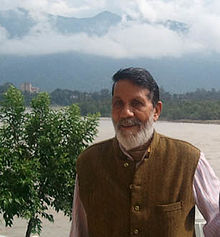
Photograph of Bhatt courtesy en.wikipedia.org
Mahatma Gandhi’s concept of self-governance (swaraj) aimed to create an egalitarian society. To achieve it, a committed group of people established Dasholi Gram Swarajya Mandal (Society for Village Self-Rule; DGSM) at Gopeshwar, northern India, in 1964. Since the objective was to develop a self sustaining nonviolent society, training was offered in village industries, agriculture, horticulture, animal husbandry, harvesting forest produce, utilizing mineral resources, employment in various construction activities, educating and awakening people for forest protection, husbanding of natural resources, etc. Gradually, DGSM become a symbol of village self-reliance. However, everything changed in 1970 when a massive flood hit the Alaknanda river basin, devastating the normal life and destroying the property. The flood was unprecedented in the history of the region, and was described by the government as a natural calamity. But the relief workers of DGSM refused to accept this, as they had witnessed the destruction of the forests between 1950-1970 in the watersheds from where the flood originated. While undertaking the relief operation in the flood-affected watersheds, DGSM volunteers concluded that the flood was more man-made than claimed.
Read the rest of this article »
by Hildegard Goss-Mayr
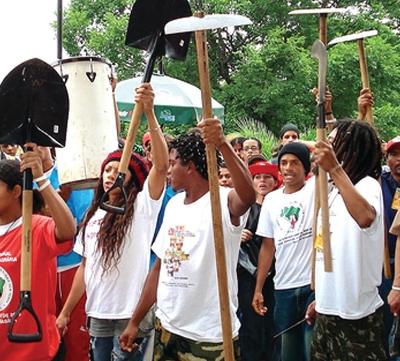
Brazilian farmers’ nonviolent land protest; courtesy mettacenter.org
Editor’s Preface: The following, previously unpublished essay was presented to the Alternative Defense Commission, as part of the War Resisters’ International Peace Education Project, c. 1987. It continues our series of discoveries from the WRI archive. Please see the notes at the end for archival reference, as well as acknowledgment and biographical information about the author. JG
In most Latin American countries military or civilian dictatorships, on the basis of the doctrine of national security, continue to uphold an economic system of exploitation that favors a small group of privileged individuals (as well as national and multinational corporations in the First World) and condemns the vast majority of the people to a life of dependence, misery, and political and social marginalization. But the masses of the poor in Latin America have increasingly become aware of their human rights and dignity, and in many parts of the continent, despite violent and brutal repression, they have begun to organize and struggle for change. Popular civic movements are springing up and pressing for justice.
Read the rest of this article »
by Matt Meyer

Book jacket art courtesy wipfandstock.com
Editor’s Preface: The following, previously unpublished essay was presented to the Alternative Defense Commission, as part of the War Resisters’ International Peace Education Project, c. 1987. It continues our series of discoveries from the WRI archive. Please see the notes at the end for acknowledgment, archival reference, and biographical information about the author. JG
To many western activists it may seem that revolution and nonviolence are clear contradictions. Nonviolence is often seen as passive, utopian, naive, or as a bourgeois luxury that we in the West arrogantly urge upon our Central American sisters and brothers. However, revolutionary nonviolence is not passive, reformist, or romantic. It is a powerful means of social change, which confronts the roots of militarism; its use in Central America has often been ignored.
Western pacifists may well be challenged about their commitment to nonviolence even in the war zones of Central America. “What do you know?” someone might ask. What we know, and what we believe history has taught us, is that revolution is a long process, with many difficult questions and no easy answers. We know that to strive for an end to war, we must first struggle for the elimination of the causes of war, including racism, sexism, class structures, and imperialism. We know that any revolution, including nonviolent revolution, will suffer bloodshed and innocent casualties, and we continue to experiment with diverse forms of resistance to minimize bloodshed and maximize lasting social change. Above all, we know that we cannot begin to talk about nonviolent revolution until we place ourselves firmly in solidarity with those already in revolutionary struggles throughout the world.
Read the rest of this article »
by Gene Keyes
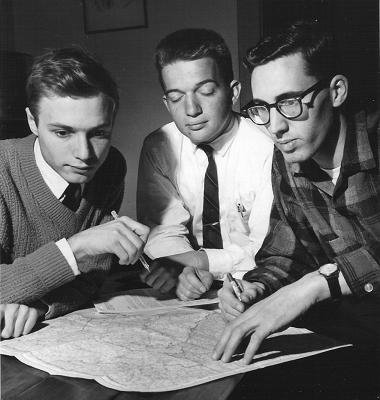
Gene Keyes, Dennis Weeks, and Joe Tuchinsky planning 1964 civil rights march route to Albany, Georgia
Editor’s Preface: The topic of nonviolent civilian defense was high on the agenda of the peace and nonviolence movements in the 1970s and 1980s. This essay is representative of that discussion, and is another in our series of discoveries from the War Resisters’ International archive. The article appears to be Chapter Two of the author’s “unpublished” PhD thesis for Toronto University; a pdf scan of the original is attached. Please also consult the notes at the end for archival reference, acknowledgment, biographical information about the author, and a link to his site. JG
The idea we are considering has had numerous names since the 1850s, and especially since the 1950s: passive resistance; nonresistance; nonviolent resistance; civil resistance; unarmed defense; nonviolent defense; nonmilitary defense; civilian defense; civilian resistance; nonviolent civilian defense; social defense; civilian-based defense; societal defense; post-military defense; etc..
An expression I would like to try out is “common defense,” but reinvigorated to mean an effort mounted by an entire polity using the nonviolent means at hand; with defiance and organization; with strategy, principle, and tenacity: common defense of everyone, by everyone, for everyone; common defense without nuclear weapons, firepower, or any other killing and violence; common defense as workaday resistance by an unconquerable free people.
Read the rest of this article »
by Gene Sharp
Editor’s Preface: The manuscript of this unpublished essay is not dated, but based on the dating of other material in the same folder, is c. 1962. It is another in our series of discoveries from the War Resisters’ International archive, which we have been researching for the last year. An archive reference, acknowledgments, and a note about Sharp are at the end. JG
The Indian government and people have responded to the Chinese use of armed force to adjust the border between their countries with war preparations and reliance upon military means to deal with the foreign threat. The Indian reaction has for many people in the peace movement, and pacifists in particular, been something of a shock. Many of these believe that India has somehow let them down, that she has failed to live up to the moral challenge imposed in different ways both by Gandhi and by the nature of modern war.
Read the rest of this article »
by Ira Sandperl
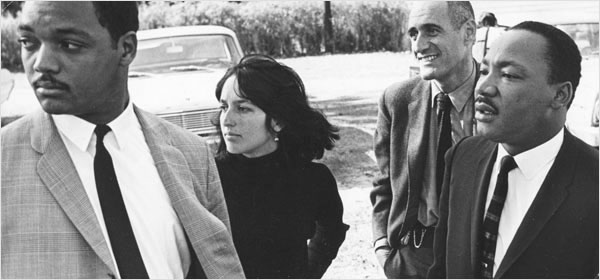
Jesse Jackson, Joan Baez, Ira Sandperl, Martin Luther King, 1964; courtesy irasandperl.org
Editor’s Preface: This unpublished essay, dated “Autumn, 1978”, is another in our series of discoveries from the War Resisters’ International archive. Please see the notes at the end for archival information, acknowledgement, and an Editor’s Note on Sandperl. JG
In 1910, the American psychologist William James, wrote in an essay that we would have to discover “The Moral Equivalent of War”, [posted below under the same date] if we were to preserve the human race. Four decades and two World Wars later the political philosopher, Hannah Arendt, in the admirable and important book, The Origins of Totalitarianism [New York: Harcourt Brace, 1951], stated that we must devise a political principle that will now cover every man, woman, and child on earth.
That political principle as well as “the Moral Equivalent to War” is what Mahatma Gandhi called satyagraha.
Read the rest of this article »
by Stop Napalm Production Subcommittee
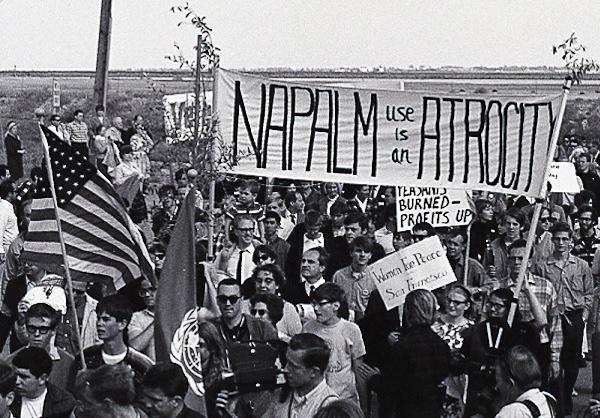
Napalm protest, 1966, photo by Harvey Richards; courtesy hrmediaarchive.estuarypress.com
Editor’s Preface: The Quaker Action Group convened a meeting in January of 1967 to discuss a nonviolent strategy for protesting the use of napalm in the Vietnam War. The two documents posted here in succession are unpublished internal memos outlining a strategy against Dow Chemical, the principle manufacturer of the deadly weapon. Among the members of the subcommittee were George Lakey, Lawrence Scott, and George Willoughby. These documents are especially noteworthy for their adherence to several Gandhian nonviolent civil disobedience principles, especially studying the opponent, and determining the weak point. They are another in our series of discoveries from the War Resisters’ International archive. Please see the note at the end for archival reference and acknowledgment. JG
You sit down to write a nice, dispassionate report on what napalm is. The paper is there, the pencils; all the facts you need to demonstrate the horror of this weapon. And you read this (New York Times, December 10, 1967):
“It comes premixed and packaged in thin-skinned aluminum tanks. There are three sizes of which the largest, a tank of 120 gallons weighing 800 pounds, and ten feet long and about three feet in diameter at its thickest point is most frequently used . . . About 1,500 tons of napalm are dropped in an average month in South Vietnam . . . Unlike conventional bombs most tanks of napalm are not provided with fins. Instead of spinning, they tumble, spreading the flaming fuel over an area in open country of about 150 feet along the path of the plane and about 50 feet wide.”
Read the rest of this article »
by Stop Napalm Production Subcommittee
Basic Assumptions
(1) The focus of the action will be on Dow Chemical Company, as the nation’s primary producer of napalm.
(2) The program will be carried out in step-by-step fashion, over a specific time period, and moving from less to more intense action steps.
(3) The action will be carried out in a variety of locations and should be as nearly nation-wide as possible.
(4) A Quaker Action Group will initiate and carry out the program in accordance with its nonviolent philosophy. Cooperation from other concerned groups is welcomed. Members of such groups, who are in accord with the nonviolent discipline, may be coopted onto the Napalm Strategy Committee of a Quaker Action Group.
Read the rest of this article »
by Gene Sharp
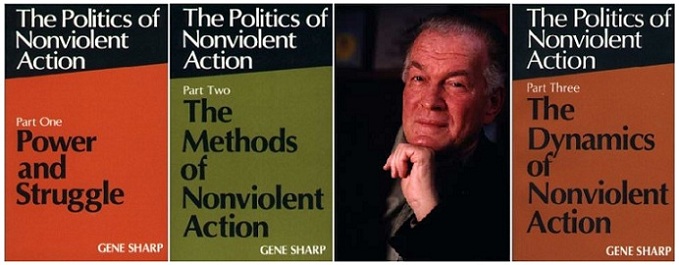
Book jacket assemblage courtesy rcnv.org
Editor’s Preface: This little known essay by Gene Sharp was discovered in the War Resisters’ International archive in a folder labeled “Ira Sandperl’s Speaking Tour of Western Europe, 1970: Background Reading.” The typescript seems to have been given to Sandperl by Sharp. We have not found any evidence that Sharp published the essay in this form, although he was to rework the material in later works, especially the section below “84 Cases of Nonviolent Action”. Sandperl was an interesting figure in the 1970s peace movement. A foremost member of the War Resisters League, (the U.S. branch of WRI), he might be better known to some as Joan Baez’s acknowledged mentor. Sandperl was also co-founder of the Peninsula Peace Center in California, which Baez also helped support. Please see the notes at the end for further information about Gene Sharp, archival references, and acknowledgments. JG
It is widely believed that military combat is the only effective means of struggle in a wide variety of situations of acute conflict. However, there is another whole approach to the waging of social and political conflict. Any proposed substitute for war in the defense of freedom must involve wielding power, confronting and engaging an invader’s military might, and waging effective combat. The technique of nonviolent action, although relatively ignored and undeveloped, may be able to meet these requirements, and provide the basis for a defense policy.
Read the rest of this article »












